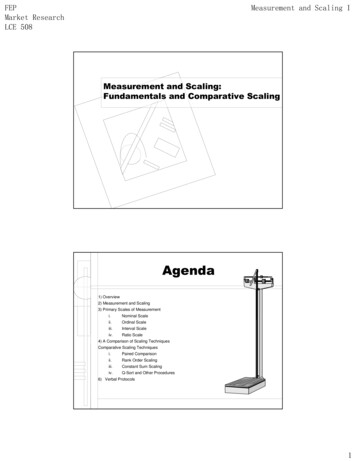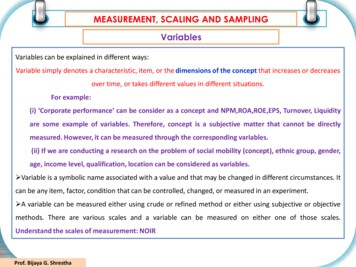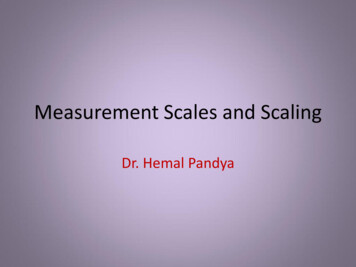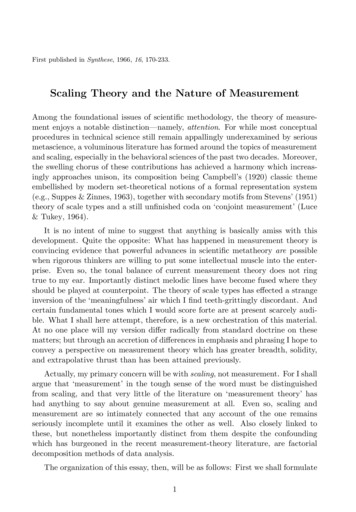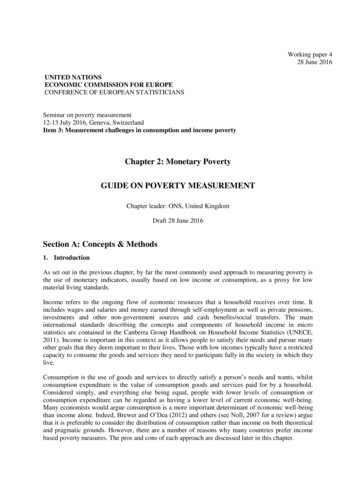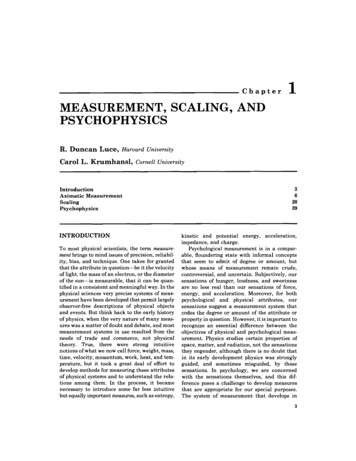
Transcription
Chapter1MEASUREMENT, SCALING, ANDPSYCHOPHYSICSR. Duncan Luce, HarvardCarol L. Krumhansl,UniversityCornell UniversityIntroductionAximatic MeasurementScalingPsychophysicsINTRODUCTIONTo most physical scientists, the term measurement brings to mind issues of precision, reliability, bias, and technique. One takes for grantedthat the attribute in question-be it the velocityof light, the mass of an electron, or the diameterof the sun-is measurable, that it can be quantified in a consistent and meaningful way. In thephysical sciences very precise systems of measurement have been developed that permit largelyobserver-free descriptions of physical objectsand events. But think back to the early historyof physics, when the very nature of many measures was a matter of doubt and debate, and mostmeasurement systems in use resulted from theneeds of trade and commerce, not physicaltheory. True, there were strong intuitivenotions of what we now call force, weight, mass,time, velocity, momentum, work, heat, and temperature, but it took a great deal of effort todevelop methods for measuring these attributesof physical systems and to understand the relations among them. In the process, it becamenecessary to introduce some far less intuitivebut equally important measures, such as entropy,kinetic and potential energy, acceleration,impedance, and charge.Psychological measurement is in a comparable, floundering state with informal conceptsthat seem to admit of degree or amount, butwhose means of measurement remain crude,controversial, and uncertain. Subjectively, oursensations of hunger, loudness, and sweetnessare no less real than our sensations of force,energy, and acceleration. Moreover, for bothpsychological and physical attributes, oursensations suggest a measurement system thatcodes the degree or amount of the attribute orproperty in question. However, it is important torecognize an essential difference between theobjectives of physical and psychological measurement. Physics studies certain properties ofspace, matter, and radiation, not the sensationsthey engender, although there is no doubt thatin its early development physics was stronglyguided, and sometimes misguided, by thesesensations. In psychology, we are concernedwith the sensations themselves, and this difference poses a challenge to develop measuresthat are appropriate for our special purposes.The system of measurement that develops in
4MEASUREMENT, SCALING, AND PSYCHOPHYSICSpsychology will undoubtedly turn out toresemble that of physics in certain fundamentalways, but new problems requiring novel solutions are also likely to emerge.Physics and its applications exhibit three distinct levels of theory. First, there are the primitive relations among attributes that determine both the measurement representations andthe interconnections among measures, asreflected in the structure of physical units.Second, there are the various laws of physicsthat are expressed entirely in terms of thesemeasures, such as the basic equations of electromagnetic theory (Maxwell's equations), of hydrodynamics, of kinetics, and of statistical mechanics. And third, certain particular systems aremodeled and the equations are solved for thosecases. An example is the force exerted on a particular airfoil in a particular fluid flow, or themovement of the needle of a voltmeter whenplaced across a particular circuit under particular conditions. Keep in mind that, at each ofthe three levels, important regularities arefound, all of which are called laws; those ofmeasurement, those of general physical processes, and those of particular physical systems.Although they all express regularities, they areobviously not all of the same type, since theydiffer in generality.If three distinct levels really can be distinguished, at which level does the psychophysicistoperate when studying loudness? If a scale ofloudness is developed, is it (1) an example ofmeasurement, (2) a part of some psychophysicaltheory, or (3) the manifestation of the operationof a mechanism? In the first case, it must eventually be shown to arise as the representation of alawful qualitative structure. In the second, it isbest thought of as a construct whose ultimatestatus is not necessarily clear; often constructsof theories eventually become basic measures,once the situation is better understood. And inthe third, it may best be thought of as a randomvariable, reflecting the probabilistic characterof a mechanism, but not necessarily having anything to do with fundamental measurement.We discuss the first separately and then lumpthe other two.The Strategy of Measurement andScaling in PsychophysicsIn following this strategy we suppose that thesensations themselves are attributes of theorganism, comparable in many ways to theproperties of physical objects. As such, theseattributes are assumed to be highly stable andregular, and thus they can be subjected to careful analytical study and represented numerically in a manner analogous to physical measurement. This approach is concerned not only withthe assignment of numerical values to thepsychological states, but also with the way inwhich the observed psychological measui-espossess various formal properties of the numbersystem into which they are being mapped. Forthe purpose of this chapter, we will refer to thisas the measurement approach.If this approach is followed and succeeds, oneanticipates the discovery of general laws relating the sensations to physical attributes. Thatis, the measured sensations are expected to correspond systematically to the physical quantities that give rise to them. This is the point ofview, more or less explicit, that has informed thetradition of psychophysical measurement thatbegan with Fechner (1860) and received majorimpetus in this century by Thurstone (1927),Stevens (1951, 1975; see the latter for numerousreferences), and many others. For example,sound intensity, that is, the amplitude of thepressure wave impinging on the eardrum, is awell-understood physical attribute that is highlycorrelated with the sensation called loudness. Itis, however, by no means identical to it. For onething, the relationship is not linear; twice theamplitude does not give rise to twice the perceived loudness. Moreover loudness is affectedby the frequency of the sound as well as by itsintensity. A more striking example, perhaps, iscolor vision. Light stimuli are described at thephysical level by the energy at each of an infinity of wavelengths, but perceptually this infinite-dimensional space is mapped onto the muchsimpler, three-dimensional structure of thepsychological color space. Thus, the relationbetween the physical stimulus and the corresponding psychological response may be quitecomplex, although this approach assumes thatthe relation is lawful.For the measurement view to prevail inpsychophysics or, more generally, in psychology, or even more generally, in biology, itappears necessary for some structure of interconnected scales to arise, much as exists inphysics. This would mean a complex pattern of
INTRODUCTION5reductions of some psychological scales to are for the most part fallible in the sense ofothers, with a resulting simple pattern of units, exhibiting a certain amount of inconsistencyand quite possibly some simple connection with and irregularity, into some familiar numericalthe scales of physics. This appears to be the representation. For example, the question mayprogram that Stevens was pursuing; we discuss be how best to locate points in some geometriit below. To anticipate, Stevens attempted to cal, often metric, space so as to represent theargue that the psychological scales of intensity psychological relationships among stimuli?are all power functions of the primary physical This approach accepts the fallible nature of thescales that manipulate each attribute. Moreover data, and is, therefore, not so much concernedhe attempted to show that a consistent pattern with verifying that the data satisfy specificof power functions holds among the scales of properties entailed by the chosen representaintensity, suggesting a single underlying attri- tion as with searching for the best possible fit ofbute of psychological intensity. Were that true, the data within the chosen class of representathen psychophysical measurement would simply tions. The fit between the original data and theenlarge the system of physical measures, just as solution is evaluated in some global, statisticalelectromagnetic theory did in the second half of sense.the last century, and one could anticipate theIn the short run, this scaling approach hasdevelopment of psychological theories involv- proved to be very directly usable. In the longing these sensory (and perhaps other) variables run, solving some of the deeper questions posedon the model established in physics.by the axiomatic approach to measurement,Within this tradition of measurement there such as defining the possibilities for measureare a number of subschools and points of view. ment, discovering how complexes of structuresPerhaps most notable is the division between interrelate (as, for example, those underlyingaxiomatizers and scalers. The axiomatizers the system of physical units), and determining(whose approach is exemplified in Krantz, Luce, what kinds of statements are meaningful in aSuppes & Tversky, 1971, Narens, 1985, and measurement structure, may have more proRoberts, 1979) tend to treat the following type of found implications for progress in psychology.problem: If a body of (potential) qualitativeThe Strategy of Mechanisms inobservations satisfies certain primitive lawsaxioms that capture properties of these observa- Psychophysicstions-then is it possible to find a numericalstructure that accurately summarizes these The second major strategy for describing psychoobservations? In technical terms, the question physical attributes is to focus on sensory andis: To which numerical structures is the set of other mechanisms in the organism. This straqualitative observations isomorphic? An iso- tegy is directed at analyzing the internal sysmorphism is a one-to-one mapping between tems responsible for the transduction, transstructures under which the structure of the one formation, storage, and interpretation of senmaps into that of the other. It is also desirable to sory information. In this view, the organism ishave an explicit process whereby the numerical likened to an information processing machine,structure can be constructed from the qualita- with the sensations corresponding to certaintive one. This literature, which is a part of aspects of its internal workings, perhaps the'applicable mathematics,' is purely mathemati- firing patterns of various key neurons that arecal in character, but the choice of structures to monitored by an executive control system. Thisbe studied is greatly influenced by the type of was probably the implicit view of most psychoapplication intended. The objective of this physicists working on sensations in the 19thapproach is to illuminate the range of possible century, including the remarkable Helmholtzsituations that permit the development of a (1867). It is certainly the dominant point of viewmeasurement system, to determine the type of of psychophysicists working in this century.system that is appropriate, and to provide at Consequently, we will call this the psychophysical approach, and the last part of the chapterleast one method for its construction.The scalers pose a different, often more imme- will be devoted to a summary of some classicaldiately useful, problem. They are concerned and contemporary work in this field. In thatwith transforming psychological data, which section, a distinction is made between local
6MEASUREMENT, SCALING, AND PSYCHOPHYSICSpsychophysics, which is concerned primarilywith sensory mechanisms that serve to discriminate stimuli that are physically little different,and global psychophysics, which is directedtoward understanding the apprehension ofsensations over the full dynamic range of thephysical signal. The dividing line between localand global psychophysics is fuzzy in much thesame way as is the transition from day to night.Global psychophysics, with its concern for therelation between sensations and the numerically measured physical stimulus has close tieswith measurement theory, which will be discussed first.What is t o be Measured?Before turning to the theory of measurement, itmay be well to consider for a moment the question of what it is that is to be measured. Psychologists are interested in a wide variety of behaviors in humans and animals, and obviously theinterests of the investigator determine to a largeextent which of the observable behaviors receiveattention. Once this choice has been made, theinvestigator faces the problem of devising anappropriate set of experimental measures thatare sensitive to the attributes of interest. In thisstep, investigators are necessarily guided to asignificant degree by their own intuitions, but ifa number of different measures converge on asingle conclusion, there is more reason to beconfident of the findings.Because of the diversity of interests in psychology, there are many different answers to thequestion, what is to be measured? The attributesof interest can be physical, physiological, orpurely psychological. In general, external,physical measures, such as age, sex, and weight,tend to be easy to measure but difficult orimpossible to manipulate by experimentalprocedures. Consequently, studies employingthese variables tend to make comparisonsacross different subject groups. Internal physiological measures, such as hormone levels, neuronal firing rate, and blood pressure, are usuallymore difficult to obtain, but they are still reducible to some physically defined values. Of these,some can be varied over a wide range dependingon the experimental conditions; others are lesssusceptible to experimental manipulation. Purely psychologi
4 MEASUREMENT, SCALING, AND PSYCHOPHYSICS psychology will undoubtedly turn out to resemble that of physics in certain fundamental ways, but new problems requiring novel solu- tions are also likely to emerge. Physics and its applications exhibit three dis- tinct levels of theory. First, there are the pri- mitive relations among attributes that deter- mine both the measurement representations .


